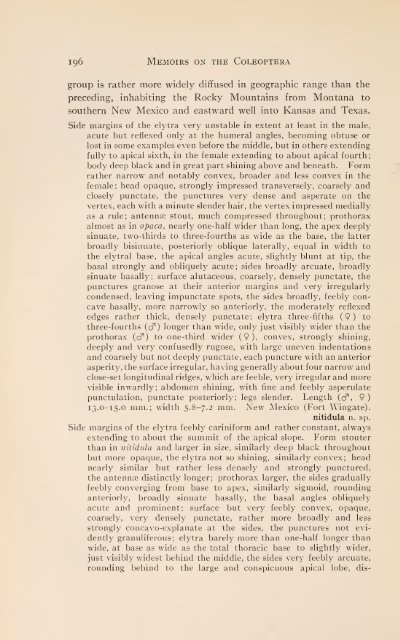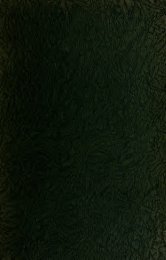Memoirs on the coleoptera
Memoirs on the coleoptera
Memoirs on the coleoptera
You also want an ePaper? Increase the reach of your titles
YUMPU automatically turns print PDFs into web optimized ePapers that Google loves.
196<br />
MEMOIRS ON THE COLEOPTERA<br />
group is ra<strong>the</strong>r more widely diffused in geographic range than <strong>the</strong><br />
preceding, inhabiting <strong>the</strong> Rocky Mountains from M<strong>on</strong>tana to<br />
sou<strong>the</strong>rn New Mexico and eastward well into Kansas and Texas.<br />
Side margins of <strong>the</strong> elytra very unstable in extent at least in <strong>the</strong> male,<br />
acute but reflexed <strong>on</strong>ly at <strong>the</strong> humeral angles, becoming obtuse or<br />
lost in some examples even before <strong>the</strong> middle, but in o<strong>the</strong>rs extending<br />
fully to apical sixth, in <strong>the</strong> female extending to about apical fourth;<br />
body deep black and in great part shining above and beneath. Form<br />
ra<strong>the</strong>r narrow and notably c<strong>on</strong>vex, broader and less c<strong>on</strong>vex in <strong>the</strong><br />
female; head opaque, str<strong>on</strong>gly impressed transversely, coarsely and<br />
closely punctate, <strong>the</strong> punctures very dense and asperate <strong>on</strong> <strong>the</strong><br />
vertex, each with a minute slender hair, <strong>the</strong> vertex impressed medially<br />
as a rule; antennae stout, much compressed throughout; prothorax<br />
almost as in opaca, nearly <strong>on</strong>e-half wider than l<strong>on</strong>g, <strong>the</strong> apex deeply<br />
sinuate, two-thirds to three-fourths as wide as <strong>the</strong> base, <strong>the</strong> latter<br />
broadly bisinuate, posteriorly oblique laterally, equal in width to<br />
<strong>the</strong> elytral base, <strong>the</strong> apical angles acute, slightly blunt at tip, <strong>the</strong><br />
basal str<strong>on</strong>gly and obliquely acute; sides broadly arcuate, broadly<br />
sinuate basally; surface alutaceous, coarsely, densely punctate, <strong>the</strong><br />
punctures granose at <strong>the</strong>ir anterior margins and very irregularly<br />
c<strong>on</strong>densed, leaving impunctate spots, <strong>the</strong> sides broadly, feebly c<strong>on</strong>cave<br />
basally, more narrowly so anteriorly, <strong>the</strong> moderately reflexed<br />
edges ra<strong>the</strong>r thick, densely punctate; elytra three-fifths (9) to<br />
three-fourths (cf ) l<strong>on</strong>ger than wide, <strong>on</strong>ly just visibly wider than <strong>the</strong><br />
prothorax (cT) to <strong>on</strong>e-third wider (9), c<strong>on</strong>vex, str<strong>on</strong>gly shining,<br />
deeply and very c<strong>on</strong>fusedly rugose, with large uneven indentati<strong>on</strong>s<br />
and coarsely but not deeply punctate, each puncture with an anterior<br />
asperity, <strong>the</strong> surface irregular, having generally about four narrow and<br />
close-set l<strong>on</strong>gitudinal ridges, which are feeble, very irregular and more<br />
visible inwardly; abdomen shining, with fine and feebly asperulate<br />
punctulati<strong>on</strong>, punctate posteriorly; legs slender. Length (cf, 9)<br />
13.0-15.0 mm.; width 5.8-7.2 mm. New Mexico (Fort YVingate).<br />
nitidula n. sp.<br />
Side margins of <strong>the</strong> elytra feebly cariniform and ra<strong>the</strong>r c<strong>on</strong>stant, always<br />
extending to about <strong>the</strong> summit of <strong>the</strong> apical slope. Form stouter<br />
than in nitidula and larger in size, similarly deep black throughout<br />
but more opaque, <strong>the</strong> elytra not so shining, similarly c<strong>on</strong>vex; head<br />
nearly similar but ra<strong>the</strong>r less densely and str<strong>on</strong>gly punctured,<br />
<strong>the</strong> antennae distinctly l<strong>on</strong>ger; prothorax larger, <strong>the</strong> sides gradually<br />
feebly c<strong>on</strong>verging from base to apex, similarly sigmoid, rounding<br />
anteriorly, broadly sinuate basally, <strong>the</strong> basal angles obliquely<br />
acute and prominent; surface but very feebly c<strong>on</strong>vex, opaque,<br />
coarsely, very densely punctate, ra<strong>the</strong>r more broadly and less<br />
str<strong>on</strong>gly c<strong>on</strong>cavo-explanate at <strong>the</strong> sides, <strong>the</strong> punctures not evidently<br />
granuliferous; elytra barely more than <strong>on</strong>e-half l<strong>on</strong>ger than<br />
wide, at base as wide as <strong>the</strong> total thoracic base to slightly wider,<br />
just visibly widest behind <strong>the</strong> middle, <strong>the</strong> sides very feebly arcuate,<br />
rounding behind to <strong>the</strong> large and c<strong>on</strong>spicuous apical lobe, dis-



